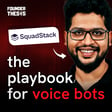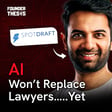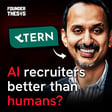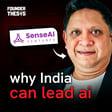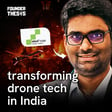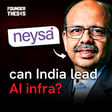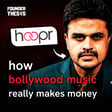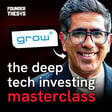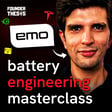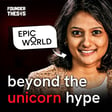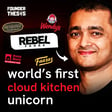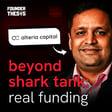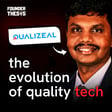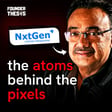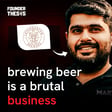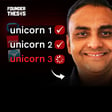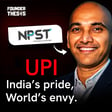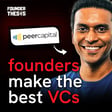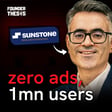Become a Creator today!Start creating today - Share your story with the world!
Start for free
00:00:00
00:00:01

A serial founder talks about building a Neo Bank | Kunal Varma @ Freo
Kunal is reimagining banking with Freo, a digital platform that covers all three key financial services: payments, savings, and lending. In this conversation, he spills the tea on the rollercoaster journey of his first business in talent assessments, which eventually got acquired, teaching him valuable lessons along the way. He talks how these experiences helped him hit the bullseye with Freo and also shares his take on the future of banking in India!
Get notified about the latest releases and bonus content by subscribing to our newsletter at www.founderthesis.com
Read more about Freo:-
1.Freo’s UPI credit: The new- age fintech redefining financial access
Transcript
Introduction and Background
00:00:00
Speaker
Hi, everyone. This is Kunal Varma. I am our CEO and co-founder of Freo, and I'm here at the Founder Thesis Podcast. Super excited.
00:00:22
Speaker
This episode of the Found a Thesis podcast is a deep dive conversation with a serial entrepreneur who is reimagining banking. Kunal Varma's first venture was in the fascinating space of talent assessments and that rollercoaster journey eventually ended in an acquisition. Armed with his learnings from his first venture, Kunal lodged India's first line of credit product for the underbanked and then spent a couple of years to get that right and then start scaling it. Today, Freo is a leader in the space and is now building a digital banking platform of the future by offering all three key financial services to consumers – payments, savings and lending. In this freewheeling conversation with Akshay Dutt, Kunal shares the challenges of the first business and how those learnings helped them get it right the second time, and also his take on the future of banking in India. Let's
Path to Entrepreneurship
00:01:11
Speaker
dive in.
00:01:22
Speaker
So, ah you know, you're a serial entrepreneur and Frio is your second venture. Let's kind of trace back on how you became an entrepreneur in the first place. Like if you could just like, you know, give like a quick, like what led up to becoming an entrepreneur, a little bit of your background. Sure, sure. um Yeah, I think um i um I was always the interested in doing something where I could see a bigger impact as an individual, right out of my engineering days. I mean, on IIT campus as an engineer,
First Venture: Tapstart
00:01:59
Speaker
ah we were all kind of split between taking the coolest jobs and like completely changing the world. And I think I was no different. So I straight away started working for an organization. And I worked for about seven and a half years.
00:02:11
Speaker
I really felt that if I were to really put myself out there and be excited about waking up every morning and long-term really easily feel proud about what I'm doing, then I had to do something much bigger rather than being an important but a very small cog in the wheel. I think with this completely vague idea of you know trying to make an impact, I decided that, look, I think its entrepreneurship is the way to go. So I think just as I turn on the other side of 30 is when I decided to take that leap. And it started with the first so-called project, ah which is like a small business right out of B-School campus, which I ran for about a year or so, like a services business, marketing service analytics, but nothing really great.
00:02:57
Speaker
but one box got immediately checked that I started making money very quickly as a services business. So that's when my first business started materializing and I started realizing that it was not really about the money yet again because I was making enough money more than way more than I would personally spend. I mean, thankfully my lifestyle had not upgraded too much. I still liked the same food and still like the same stuff mostly. um i um I then realized that I had to do something bigger, more structured. So I think the learnings from being an engineer, having worked in a professional setup, what kind of putting coming together in my head.
00:03:36
Speaker
um And that's when I started my first real business, which then came to be known as Tapstart, which was an education and talent analytics platform. That was a fun ride.
Birth of Freo
00:03:48
Speaker
um It was a short ride, not more than five years, but um you know it was a good ride, which came to a logical conclusion, starting from zero again, funding it myself, then getting a co-founder to join me in the journey when things started getting serious. and then you know doing all the right things in terms of making money, serving customers, um and then you know seeing that there was an exit in sight and taking that exit. um and ah and Once that happened, I knew that part unemployability and part having tasted what entrepreneurship was able to bring out in me, I realized that I was not getting enough.
00:04:31
Speaker
And i i think the last thing that came to my mind was the amount of money to be made or I had made or I would i would make. ah Fortunately, I've been prudent. and Like I said, my I've not ah dramatically upgraded my lifestyle, which allowed me to just be simple. um So yeah, I think that's when the pieces came together in my head for the current business, which today we call as Freo.
Innovative Banking Solutions
00:04:56
Speaker
When we started off, again, it was my idea. we idea start Freo, I want to zoom into a little bit of the tap start journey.
00:05:06
Speaker
ah When did you feel that you have found product market fit? And I mean, you know, this is again with the power of hindsight. Well, I'm sure at that time, even the concept of product market fit would have been alien. Yes. and ah What was the product and the market? Just tell me that also. Well, was it It was the marketplace. The product by itself was a platform wherein ah we had created adaptive dynamic assessments
00:05:37
Speaker
ah for different professional areas. For example, a working professional ah working in a company would find value in using our platform in order to assess their skills on various areas. For example, digital marketing, equity research, financial accounting, operations theory. ah We had about 100 On a good day, we had 100 very good powerful assessments built on technical domain knowledge created by experts of the industry. And with that, we had created an assessment system just like a GMAT or a CAT, which increased in you know difficulty based on your capability as a professional. This allowed working professionals to evaluate themselves and match themselves to good opportunities from a work and upscaling standpoint.
00:06:26
Speaker
So we had a lot of investment done in content creation and assessment creation, which would be practical from a job standpoint. And on the other hand, this platform was also being used by institutions like corporates and then eventually the government to evaluate their employees or potential candidates based on the work areas. And institutions and then the government was willing to pay for this. And for individuals, we had provided it as a free service. So in that sense, it was a marketplace, a platform running as a marketplace where revenue was a B2B model and consumption was B2C. But of course, the network effects were driving the value of the platform up.
00:07:05
Speaker
So this was the product and you know and does the market like a two-sided marketplace in that sense. i I think I remember very clearly that around 2013, early 2013 is
Understanding Line of Credit
00:07:17
Speaker
when I was convinced that we had product market fit. And the reason we were convinced about it is because ah we were able to consistently convince institutions, both corporate as well as academic institutions, that this platform would give value and they were willing to write checks.
00:07:37
Speaker
and we started getting the revenue in um as ah as a front-loaded like an advance. So in a let's say a corporate or an academic institution found value in the platform and let's say the the ticket size for let's say five lakhs. we we started getting like 2 lakh rupees advance payment or 1 lakh advance payment depending on the commercial model and a 5 lakh revenue stream maybe spread over a one month or two months would start coming in upfront. So my working capital started getting addressed upfront and once that became a repetition like a three or four clients coming in, we knew that there was something which people would pay for and that in our head was the sign of a product market rate.
00:08:18
Speaker
Okay. Interesting. And was there a focus on say technical, like say software and these kinds of assessments or psychometric assessments or like what what kind of assessments? Yeah, ah we did we didn't do psychometric assessments at
Partnerships and Challenges
00:08:36
Speaker
all because psychometrics were being addressed by a lot of expert players in the market. There are these you know very well-established psychometric assessments used by companies for the past 20, 30 years, personality types and the AI, MBTI, MIIs, breaks and so on and so forth is to degree feedback. There are a whole bunch of them. And we realized that there was no incremental or additional value that we could bring on the table.
00:09:03
Speaker
But functional domain skills, analytical skills are basically tradecraft in different domains, whether it is marketing, finance, operations, analytics, and different. So, I would pick like eight to ten top domains. Within each of those top domains, we would break it down into eight to ten individual work streams, like within marketing, there would be search engine optimization, there would be digital marketing, there would be performance marketing, there would be marketing research and analysis, um like that, you know, in finance would be equity research, brokerage, and um and so on and so forth.
00:09:40
Speaker
So like this, we had picked 8 to 10 top world domains and within those, we had 8 to 10 streams. So roughly around 100 plus. And we were on the path to you know scaling this up. Probably every quarter we would add one or two ah big domains and within that about 5 to 10 new stuff. While at the same
Digital-First Approach
00:09:59
Speaker
time trying to keep the current content up to speed with the latest market trend. So that was the area that we focused on. And I think this did not have too much of a competition. And what was your customer acquisition strategy? How how were you doing sales? Well, we were very scrappy um in that sense that you know on one side, it was a lot of ah growth hacking, a lot of actually sitting and creating content, getting people to ah find us in through inbound search engine optimization, traffic, backlinking, that kind of stuff. So allowing for organic discovery.
00:10:36
Speaker
And on the other side, it was actually approaching B2B clients and customers. And that was a lot of actually pounding the pavement, cold calls, getting dejected. So me and my co-founder would, you know on on ah on a typical day of sale, ah while you know people from the outside think that you know it's so glamorous to like sell and negotiate and we see all these movies. but A typical morning would be like we would get up, we would get into one of our cars ah with a fully charged phone, and we would open Google Maps, and we said, look, we have a list of these customers or clients that we are supposed to knock on the doors. Let's hit West or North Bangalore. And there would is 20 guys to cover. And if we had leads, we would go to them first. If we didn't, there would be a complete day of cold calls. So there would be a day of cold calls.
00:11:32
Speaker
meeting, pitching, trying to sell ourselves, trying to sell the value. And then, you know, the objective of the meeting was to first of all, not get insulted and thrown out, you know, like turn the night in with some self-respect so that we have enough motivation to get up the next morning. That good itself would be a win. And then sometimes the more the objective was to ah do a meeting so that we can get the second meeting so that there is some incremental value. So sales pipeline can be built. And I think this is how step by step, inch by inch, brick by brick, we created a
Entrepreneurial Lessons
00:12:07
Speaker
sales funnel and we started converting. So we got academic institutions, we got companies, then eventually through our connects everything, we got the government, the National Skill Development Corporation became our client on a retained basis for the telecom sector, skill development council and a couple of others. We got them impelled and they were using our platform across 400 cities for assessment. So, but this all happened after a lot of what I explained.
00:12:32
Speaker
Amazing. How did you overcome that hesitation? Because you were an engineer who had worked in a like a tech role from yeah from that to going out and doing cold calling or you know knocking on doors, hoping to get a meeting.
00:12:50
Speaker
yeah i think of um ah I think having good communication skills and being in a very active ah part of the debate club in school ah was probably something which was hard hardwired into me. So I was always good with communicating and um and having walk i having grown up in a family where ah there was a lot of importance given to how you communicate, how you speak with people, basic etiquette, basic manners.
00:13:23
Speaker
actually played out to my advantage. ah Now I think that, you know, growing up and even through your education, ah especially in today's times, one should over index on that capability. Unfortunately, it was just something which was kind of part of me. ah But then again, I think working through tough problems. I think my first seven years, seven and a half years of working in a corporate setting in a very intense work environment in hardcore semiconductor technology, the industry that I came from. Working through really tough problems, working with very smart people, trying to put my ideas across.
00:14:00
Speaker
I think a combination of all of these things helped me to break a problem down, no matter how harsh it
Digital Lending Ecosystem
00:14:08
Speaker
seemed at first. And that to say, okay, you know, this one step, if I do this one step, then I can put my foot in one foot in front of the next foot. So it always allowed me to create incremental progress. So, it was not so black and white fortunately for me. that you know Either I have failed or I have succeeded. So, I could always see some progress happening and that allowed me to keep going. That was one. I think partly it was also a little psychological. and Now that I have taken this leap, like you know what should I really do? like you It's not like I feel bad because
00:14:45
Speaker
You know, this guy did not even, the assistant or the peon in front of an office did not even give me an empty chair, asked me for a cup of tea. Whereas, you know, I'm far more worthy of that. I think there were a few initial weeks where I had these. pangs of you know dilemma, questioning myself and like really my value. But I got over it. I think um that's been like one major life lesson which I even follow even today because that i you know on an average,
00:15:16
Speaker
in an average lifespan, you know, I have more bad days than good days as an entrepreneur, but I learned something very early on and that helped me in tackling this. So I kind of got out of, you know, I didn't like, and I had to get out of my own head and okay, I'm an engineer, I went to IIT, I'm like, for what? i you know You know, I have to kind of go be move on and I know, earn my lunch. I think eventually the world taught me this. So I think I learned that lesson and fortunately, I was lucky enough not to be too thick headed
Targeting Middle-Income Consumers
00:15:49
Speaker
and I'm just a little humble. So I think that helped. Amazing. Amazing.
00:15:55
Speaker
You know, the interesting thing is that this space that you were trying to build enough non-technical assessments is yet to see any large players. Most of the large players are on the coding side, you know, companies like say, rank hacker. And most of them are also earning more revenue outside India than in India. ah True. true this I mean, the the space itself was possibly not one which had a A lot of potential to scale in. takers Yeah, absolutely. You're right. It's partly if you if you read the tea leaves of where we are as a country, there is no surprise here.
00:16:35
Speaker
ah Look, I think today, if we had continued that business, we would be part of the edu tech sector, who knows what would have happened during COVID and after COVID. Like, you know, you can always second me guess things could have been worse, things could have been better, who knows. But I think there are some few key patterns as a society, um while I think there's massive awareness in certain parts of the society, ah wherein people are relying a lot on knowledge-based careers. ah The value of skills is
00:17:13
Speaker
I think becoming more and more apparent and there are lots of startups, institutions which are investing ah in both customer education and real products, which is excellent. But I think ah yeah i mean the the value has been much less specific specifically for this and it's partly because if you look at how developing societies versus developed societies operate, ah you will see a key um some few key differences. One pattern you would see that in ah in a developed economy or a developed society, people consume a lot of services.
00:17:47
Speaker
Whereas our developing the economy or developing society, we still are very, very large consumer of goods. We are not yet large consumer of services. and We don't want to pay for convenience, which is a service. We still want to pay for the good like you know goods. like you know so yeah i have um i And hence, for example, I will buy a product, but I will not value the service as much. If I'm charged extra for the service, I start questioning the relevance of that service. I think, you know, what difference does it make? was like you know Ultimately, if I get it, I will take it, obviously, because I want that also.
00:18:24
Speaker
But I don't want to value it so much, which means I don't want to put my money where my mouth is when it comes to service because we are still like a developing society and a developing economy where we value goods far more than we value some services.
Product Development Strategy
00:18:37
Speaker
Again, it's not black or white. A lot of us value convenience and time far more. But like I said, if you were to you know use some broad strokes, I think that's where we are. And I think that's one of the reasons why a lot of skills and skill sets, you would still see that like ah you a far a huge like a miles to go before you see the same amount of value being placed on that as against
00:19:01
Speaker
an e-commerce website where you could actually buy goods immediately because you saw it in a movie or you saw the Western markets or you saw an ad. I immediately want that new shiny thing, but I'm not sure I want to invest so much on my skills because it might pay off eight years, seven years from now. Not so much. I think and and that's the reason I guess. Though um I would argue you your the side of your business is just a distraction, right? I mean, why even bother with it? Because assessments generally are of value to employers because it leads to meaningful reduction in wrong hiring or time taken to hires. You know, both of these are meaningful value ads.
00:19:46
Speaker
True, I think ah and hence we were very clear that who would see this as valuable enough to pay for it. I think this so and this was very, very clear ah in that startup and it's it's so amazing that it's almost like first principles. You know, if you have somebody paying for something, that is ultimately the unfiltered definition of real value. No matter how much I can say, no, no, there is value in something else, but people are not paying for it. It's just the way we are wired. I mean, we place value on something when we are willing to abandon something for it in exchange for it. And I think today the most precious thing as a society that we value is money, not time yet.
Scaling Challenges
00:20:32
Speaker
So, forget about people spending time. Who is willing to spend the money? And that's the strongest, ah I would say, unambiguous indicator of real value and the not the real indicator of product market fit or a success. So, B2C was needed, the site was needed for, you know, actually creating value at ah at ah at a consumer level because if I could not see individuals Using the platform, I could not convince the corporate that the individuals that you interview or you evaluate or you put through for an appraisal will actually benefit from it. The sell would be very hard and it would be a sell. It would not be convincing. that I could not say with a straight face that this is a valuable platform. Use it. The moment I saw B2C uptake,
00:21:21
Speaker
the take rate going up, I was very convinced. I could go with the street face and, you know, talk to my clients that, look, this is a real value and, you know, you got to try it out. And that also gives you the conviction to tell people, why don't you try something out for free for some time? It's like a warranty, right? I mean, you know, you go and buy a product and a product with 10 year warranty versus a product with a six month warranty. It kind of, it it gets you thinking like, why is this guy willing to give you 10 years warranty? Because it's far more kind convinced about the value of the product. very similar here. So I think it played a role, but the ultimate bang for the buck came from B2B side. So I think you're absolutely right in that, but that was a role to be played.
00:22:00
Speaker
Interesting. So did you actively go out looking for buyers or it just happened that you were ah approached by a strategic investor or like what happened? What led to, because, you know, most founders while they're actually running the business, don't think of selling out, you know, yeah yeah yeah it's a very rare founder who is able to dispassionately say, look, this business doesn't have legs I need to exit. True. um ah You know, depending on how emotional I get an explaining thing, this answer takes like different versions. And as much as ah I would like to sound very smart and intelligent and calculated about it, let me tell you that it just happened. It's just one of those things which like now I have learned with ah enough experience in my life that a lot of things, they just come to you and how you see it then decides whether it is a distraction or an opportunity to you.
00:23:01
Speaker
And I think that at that time, there was a mix of a few things happening. ah ah One is that we were pretty convinced that the way we were scaling up the business, it was getting
Lessons from Tapstart
00:23:13
Speaker
more and more difficult for us to see this business becoming like a hundred exercise. Like do what would i would I have like a hundred times the number of corporate clients or institutions willing to pay the same amount of money in a finite amount of time? Maybe there would be, we didn't see it. I needed to see a line of sight. While it was growing, I was already profitable. The revenue was running into crores. I was already profitable as a business.
00:23:42
Speaker
we had risen angel round and we were profitable after and raising the, I think within one or and a half years of raising the angel round, we were profitable. So I think the angel investors who obviously, you know, kind of bet on us because they partly believed our story and partly because ah they were just like very good people who wanted to bet on a future entrepreneur. They probably saw some part of themselves in us. ah they They kind of believed in the decisions that we would take because we had turned the business profitable.
00:24:14
Speaker
So we saw an opportunity of, well, you know, some clients of ours, clump client of ours, which are using this, would probably be willing to take it off our hands. And at the same time, we didn't see this becoming 100X. And by this time, we had started asking these questions. And when you jump into a business as ah as a complete, a complete greenhorn. You don't really ask these questions, but I think a few years into it, you start asking this slightly bigger directional question, like, is it the right boat that I'm rowing? You know, is it the right space? Like, you know, ah no matter what space I choose, I'm going to work as hard. So is it the right space? And so I think by this time we had developed some entrepreneurial maturity to start asking these questions.
00:24:59
Speaker
And the answer is not too obvious. And that and got us thinking and something came and then we said, look, you know, the opportunity cost is also there. So it was either maybe letting somebody take it off our hands or it was then pursuing it further and raising ah an institutional fund round and then pushing forward. And we did not choose to take an institutional funding round. We were probably ah two months away from actually getting into an actual term sheet or institutional funding round. Uh, and we didn't, and and we decided that, look, somebody had an interest and we said, okay, let's figure out the next thing to do and let's take it off our hands. And I think that's what happened, but I think the optionality was there because we were in the money. If we did not, I would not be able to have this conversation with my investors of that time with a
Impact of Past Experiences
00:25:50
Speaker
straight face because I would have, uh, probably not had,
00:25:54
Speaker
that self-respect. She said, look, I took your money and then I want to like give up. Sounds like a give up because when you say I want to do this, but I had made money and I knew I had told my investors that, you know, this is where the options are. And they said that, look, we invested in you to see if you could make it successful. And yeah there is a line of sight for us getting an exit without taking a haircut. Well, you know, you guys decide what you want to do. I think that's how it all happened. And then we can open up. kind of hold on who acquired it and for how much
00:26:27
Speaker
and there There was an institutional client out of Southeast Asia who bought it, but it was a product sale. um They bought the IP. ah So we retained the the the corporate entity in India, but they bought us the asset of us. So it is not a complete company strategic sale. um and But they bought us the IP. So it was an asset and an IP sale while we retained the corporate, which then took us three to four years to wind up and shut down, but the asset was bought over. Okay. Okay. So, you know, now you and Adruch have got an exit. You probably have some cash in hand. ah How did you decide on what to do next?
00:27:12
Speaker
So, um you know, the the main thing that came in front of us was that oh We wanted to do something bigger. And the reason why it got us thinking on our older business was because we didn't see it becoming too big. And we were like, look, if I keep hustling ah while knowing at the back of our mind that it cannot become as big as something potentially else could, then maybe we are and are doing injustice to ourselves. So I think the question always was that, is this going to be big enough? Am I going to be bigger enough? and Am I going to be putting 100%? Am I going to really create a massive footprint? So I think those were the questions we were asking. And at then at the same time when we were taking App Start off our plate,
00:27:58
Speaker
ah We kind of brainstorming about what else and our third co-founder Bala and Anoj and I, we kind of all put our heads together, sitting over a, um I don't remember if it was a coffee or a beer, but you know somewhere you know in a late afternoon on a weekend sitting at a restaurant by the poolside and we were talking about what next to do with our time. ah You know, all of us had still had like, you know, the best years ahead of us. You know, obviously we're not like 20 year olds and we were like mature enough at the same time. We were not looking at and retirement. We had like a few decades to go. So we're thinking, okay, like, you know what next? And I think the whole conversation around how things are evolving in the Indian ecosystem, India stack, our car coming in, changing the landscape of how Indians would look at data and bes would look at a transaction.
00:28:52
Speaker
This played a key role in seeing that our day-to-day lives, especially in terms of how we dealt with money, would change dramatically with all of this happening and that pushed us in the direction of financial services. And then applying our native thought process of technology, problem solving, business, consumer thinking in the domain of financial services allowed us to germinate the whole idea of creating the business. And there were some bits and pieces, Bala already had a some kind of sort an idea of framework in his mind.
00:29:32
Speaker
and then we all put our heads together. I think one thing led to the other end, there was like a phase of trying to like run like zero to 100 miles per hour sprints every week because you're trying to figure out, should I work? Should I not work? What should I do? Talk to customers, explore opportunities. At the same time, you want to slow down because you wanted to make sure as and as an entrepreneur that your next gig has learnings, right? You don't want to have this deja vu feeling that, oh my God, like, why did I not think of this, uh, having gone through this three, four, five years ago? So we wanted to slow down in terms of judgment and decision-making at the time, at the same time, we want to run super fast and exploring all aspects, sort of chaotic fun time. You're on a, you're on a high that, you know, it's something exciting. And I think that
00:30:22
Speaker
ah intellectual adrenaline pushed us to get clarity that financial services with a technology flavor to it, which is fintech as we call it now, ah for Indian consumers, for the Indian market, is where we wanted to operate. So I think as long as that became clear in our head, everything from there on oh kind of fell in place, you know, talk to customers, talk to suppliers, figure out the nuts and bolts of product and economics. And then I think the starting point became clear.
00:30:57
Speaker
And I think that's how it's all put together and came up to you about. And then, you know, he was part of, I think that the, that team would set up the other. So he, that's right. That's right. Yeah. Yeah. Yeah, I think so many things come together, right? I mean, you realize that you know there is no silver bullet. ah many ah Many advantages, small or big, add to that mix. And Bala's exposure, understanding, having been an ex-entrepreneur and an investor himself, having worked here, and all of us bringing different perspectives put together
00:31:41
Speaker
I think gave us some natural advantage as a team and we can leverage that. And why lending? ah Did you think of other ideas also or soul like lending was like the the big market, the big will? Yeah, it was the big way. I must be honest about it. But it was also the toughest one um to go after. um I think today, Frio is far more than lending. We started as a lending only platform with the MoneyTap brand name. And you know then we created Frio, which is a complete digital banking platform today. But lending is just one vertical. But back then, we very clearly understood that the biggest demand, biggest need, biggest area of impact would be credit.
00:32:26
Speaker
and yeah And we could do justice by not only bringing our thinking, but actually creating a product that we thought customers would value several times more than what they were getting in the market. So we saw that we could actually create a product which was maybe I don't know, maybe less for the lack of any other word 10X better. It was not just incrementally better than what a regular consumer was getting, but could be 5X 10X better. So we created the concept of a line of credit, a credit line.
00:32:59
Speaker
And the technical solution that we created for putting together a line of credit on a smartphone, an app, the entire complete architecture and flow. We actually filed a couple of patents for it as well because we are the first company in the country to go after it. ah So I think product innovation was at the heart of the confidence that we got that, look, this is the right space to go after, not just because it was very big. That's not always the best way to look at a problem. But one framework was that we could create a
00:33:32
Speaker
a dramatically better product. The other framework was massive opportunity demand. Third was that financial services in general and credit particularly is not a winner-take-all market, especially in most developing economies, even in developed economies, but particularly in developing economies, because it's still a distribution game. It's not yet a game of financial spread wherein you're trying to minimize your cost of capital from 3% to 2%. We are still our distribution play. Financial access is like glaringly missing. So those things played in our favor and that's how we started with credit.
00:34:09
Speaker
And how does a line of credit work? but At that time, I guess banks would either give a loan of X rupees or yeah a business could get like an overdraft facility. But for a consumer, a line of credit was not really a thing which banks did. And you needed a bank to run the product, right? Because you did not have an NBFC license when you started. and
00:34:37
Speaker
Absolutely. ah Yeah. ah So the way a line of credit works, let me address that part of the question first. So um I think you rightly mentioned like an overdraft facility. It's conceptually similar to that. right So every business gets like a line of credit from a bank saying, okay, I have a factory as a company and I'm trying to run ah machines over there. Every month I need some access to capital. So let's say a business says that I want access to maybe one crore of capital, but some months I might only use 50 lakhs. Maybe six months later I might use 7, 80 lakhs. Sometimes I might use one crore depending on demand and supply business cycles, but I want access to that pool of capital, whether I use it or not.
00:35:22
Speaker
So essentially, what every customer ah could also have is the same value. that look You have access to a certain high amount of money. You don't need that money all the time. Today, what is happening is whenever you need to borrow, you go for a personal loan. But most people in India, like 80% of people in India, don't need personal loans all the time. Our needs of money vary in size. So a regular family, a middle-income middle-class family living in a tier one hundred ti or tier two town, sometimes might need money for a medical emergency suddenly. Credit cards may or may not be accepted at that point in time in an emergency. You might need money because you need to pay a deposit on your house or a rental deposit. ah School fees is coming up and schools don't take credit cards. um They don't have a machine like ah you know like a digital store, like go and swipe your credit card on a fees.
00:36:21
Speaker
right and that and not everybody uses online and everything is working. It could be a wedding in the family and you need to have a six month planning on capital. You need to book the venue six months in advance. So you need to pay a deposit. Then maybe two months before you need to pay the caterer and three weeks before you need to pay the florist. And on on the day of the wedding in the morning when the guys show up, the infrastructure guys show up, they need another installment of down payment because they won't start your work. And then after the wedding is completed, the next guy next day guys will show up to take the balance payment. So you see how the needs of a family vary. This is very different from the way a structured personal loan offer works.
00:37:07
Speaker
where the bank said that look, I can give you a minimum personal loan of 2 lakhs, 3 lakhs. Below that I cannot give you because the interest I will earn on it is not enough to cover my costs. I need to pay for the branch, people, forms, you know, everything. and the cost of KYC, credit score reporting, blah, blah, blah. so Banks could not fill this gap or a need. but The only option that people had was to somehow struggle. Go ask a family member, ask your uncle for money. but How many times will you ask that same uncle? Your social capital is depleted. You go to an informal money lender, but you know the rates are exorbitant.
00:37:48
Speaker
And people are inherently good. You realize that, you know, not everybody's out to take the money and run away. People inherently are not bad. You know, they have genuine needs and they're okay to pay it back because they want to retain their place in society. They want to retain the trust capital that they have built. in their environment. So they are not inherently bad. So they will pay you back and they understand that they will have to pay interest and they will pay it to you. But you need to treat them with respect. You need to give them that value.
00:38:19
Speaker
So once we understood this part of the problem in the customer psyche after talking to a lot of people, banks, we put the product together saying that we will bring this convenience to every consumer on their smartphone where they can download an app and go through a digital process where they don't need to take off from their office or leave their home, walk into a bank branch, stand in the queue. They can download an app, go through a process and this is where India Stack ah digital KYCs all helped us and they could apply just like they would for a personal loan but instead here we would give them a line of credit and if they got access to a line of credit now they could keep it with them for two years three years and whenever they needed to borrow money they could open their app and say oh well I have a five lakh rupee line of credit today from 3.0
00:39:08
Speaker
But today I need 35,000 rupees. So let me enter 35,000 rupees on the app. And let me choose my repayment plan. I can pay this back in six months, or maybe three months, or maybe two years. All those options show up on the app when you're deciding how much money you want to take from that line of credit. At that time, you choose your payment plan and you confirm. You get the money instantly in your bank account. And as for the payment plan, you can start paying back every month. And as you start paying back every month, your limit gets topped up. So like a credit card or like a overdraft conceptually, but very affordable, convenient, and um I would say flexible. And people needed this flexibility. And they're convenient. So you couldn't make them jump through a hundred hoops and you know stand on your head and do yoga. And then only I will you know give you this. No, it had to be flexible. It had to be convenient. And at the end of the day, it had to be affordable.
00:40:07
Speaker
So when we were able to put this together, I think the customer value proposition was crystallized, but it spoke to all the banks. ah And I would say 80, 90% of the banks conversation that we had went nowhere. All bank CEOs that we could get access to that we are seeing in management, everybody told us that this was a ridiculous idea. ah Nobody wants a credit line. No Indian consumer understands credit line. People only understand personal loan. People know the trust of a bank. Why would they take anything from any digital app? So there were a whole bunch of typical incumbent ah driven reasons. We still decided to go ahead because we had first principles conviction. We just needed to convince one guy and we got ah somebody to work with us on the bank side and that's how the journey started.
00:41:02
Speaker
The bank made this product for you like it because this was not like a pre-existing product, so they would have had to... Yeah, yeah we had to co-create... Yeah, we had to co-create the product actually with them, which is going, so like, ah ah you know, countless white boarding sessions, architecture diagrams, ah money flow conversations, understanding compliance, understanding money movement rules of RBI, of banks, of payment systems, understanding tech limitations of internal banking systems.
00:41:38
Speaker
I think we had to put all of these together. so We were constantly fighting like a you know like a moving Rubik's Cube. We do one thing and something else comes up. Oh, we didn't think of this and we didn't think of that. So it was a co-creation of a brand new product. And we were fortunate enough that whichever bank partner agreed to work with us, ah the the individuals on their side were as excited about creating this product as we were and it seriously would not have happened without them. It's like so many people's motivation and goodwill and hard work and commitment came together and we put like a, you know, like a hundred pieces puzzle suddenly together and it looked like, well, you know, this was so simple, but in creating it, we had to like really, really
00:42:25
Speaker
We really had to do yoga on our heads, but it came together. Yeah. that Is there a reason why you're not mentioning the bank partner's name?
00:42:37
Speaker
No, not at all. I think this is a RBL bank. um um And we have very high regards for the team in RBL bank ah that helped us. Of course, the bank is a very large institution. but nasb is very in differently They are, they are. Now, I think a lot of banks have taken that stance ah because they've realized that, yeah, now I think partly that and partly they see the genuine need for it. But yeah, I think the specific team members within RBL bank that work with us and go creating, I think we owe a lot of our initial success ah to that deal. And in this whole transaction, does the money hit Freo's account as well or it directly goes to the customer from RBL?
00:43:26
Speaker
Like yeah are reviewing the banks as per as per RBI is RBI is an NPCI payment policies and the money movement rules. ah We did not have an NBS license in this equation. So we obviously had customer experience journey controls and a lot of other things working where we were in the driver's seat. But the money flow was directly as per RBI regulated knob, which is going to the bank, the customer, and we had to manage the experience all of all of that and also deal with the um the the transaction complex complexities of managing the app information, the backend information. So a lot of technical server integrations, but money flow was not through CO2 directly from bank to customer, customer to bank.
00:44:17
Speaker
And ah so you would have been like a digital DSA for the bank. Like like banks have the DSA who source loads for them. So you would have been like the first office guy. So digital yeah sort a digital DSA is probably like 20% of what we do. ah So digital DSA digitally sources. um let's say a customer for a bank, it fills a lot of the required information and then then sends that lead as a package to the bank. And then the bank decides what to do with that customer. And if that customer converts into actually a paying customer, then the digital DSA gets a commission.
00:44:55
Speaker
ah our ah Our world is different. We take responsibility for not only getting the customer, but taking the customer through the entire onboarding journey on our app and our ecosystem. And once they're onboarded for a particular product, because of the deep integration that we have with our own NBFC, any other NBFC, or basically the backend money movement channels, the entire ecosystem of using the product, not only just becoming a lead for a bank, but actually coming on board, verification, digital signatures, KYC, using the product, transacting the money by pressing buttons, repaying, managing your bills, payment reminders, the entire money movement transaction experience flows through us, the processes created and managed by us.
00:45:46
Speaker
So depending on the backend banking system or partner, or whether it's the our own NBFC, the level of integration, the level of complexity varies. You have to take into account the regulatory requirements, compliance, complexity, cybersecurity, and so on. But within all of those constraints, um managing the entire product experience for the customer end-to-end, life cycle and retaining and maintaining that customer in that product ecosystem for several years. That's what we do, which is very different from our digital DSA whose job is only to source a customer, send it to the bank, now go to the next customer, source and handoff. So we don't do source and handoff.
00:46:29
Speaker
give me see you they become example of Who's a digital DSA like in the FinTech ecosystem? Like India Lens? Yeah, I think they would be. i then India Lens ah could be, ah there could be ah let's say, Andromeda, which is a traditional DSA. um If you're buying insurance policies of a let's say policy bazaar, where you say, oh, I have an HDFC or Go insurance policy, they're like a lead generation for the insurance provider in that sense. so so this so
00:46:59
Speaker
They play an important role, but that's the role they play. They're not the you know the product. The customer does not buy the product or get product through them. As in that they don't exist on their ecosystem end-to-end. They're just responsible for sourcing and handing over. so Who does underwriting in your case? and and I'm sure this will reward.
00:47:22
Speaker
Yeah, I think it has evolved tremendously for us. ah Today, lending is just one vertical for us. And within the lending vertical, we have multiple partnerships. In the cases where our own and NBFC is used, we obviously do full underwriting and collections. In cases where we have risk sharing and or DLG arrangements with bank and NBFC partners, there the underwriting is done by us and collection is done by us within the definitions of what the egg glitter allows. ah And then there are certain commercial arrangements where the underwriting and collection is done by our ah by our capital partner. then We are only doing the other aspects of the product onboarding, transaction management and retention and repayment management and stuff like that. um and so on So I think various
00:48:10
Speaker
products, back-end formats. For the customer, it's all the same. They don't understand what's happening because they are coming and experiencing it on a free, they're pressing buttons, they're getting the value, but and the back-end multiple ecosystems. But we have a full-sledged risk, data science, collections, analytics departments, are because now we have to cater to all of these aspects of financial services ourselves. Okay. and you You spoke of a DLG arrangement. What is a DLG arrangement? but like a Digital lending guideline as laid out by RBI wherein, ah you know, when you're doing digital lending a credit to customers in partnership with banks and NBFCs, it's essentially a commercial model that you can get into wherein you can share risk.
00:48:59
Speaker
and revenue within certain constraints laid out by the regulator. So that and the both the bank and NBFC and at the digital partner, everybody has the right level of skin in the game. So there are some constraints and guardrails laid out by the regulator. That's what I was referring to. And this was earlier called FLDG. That's right. So it's a first loss default, default guarantee. So now the digital lending guidelines laid out saying what is first loss default guarantee, how much of it is allowed, who can get into these kinds of agreements. So this all comes under that umbrella.
00:49:39
Speaker
so Okay. and Understood. So the spectrum of how a FinTech works with a bank would be like, on the one side is where the FinTech is taking no risk, you get the paid per loan, which is the digital DSA model, like an India lens would do. And then on the other extreme is where you are sharing risk and you give them a first loss default reality that in case this portfolio has default for the first 10 out of 100 rupees, I am responsible for that, where you get a bigger share of the spread. So is that the right way to look at this? they they get to a spectrum yeah Yes, I think broadly it's correct. i so One end of the spectrum, you don't have any skin in the game to speak very broadly. And so you get some upfront share of revenue. But because you don't have skin in the game, you have no power to control the downside or the risk in the business.
00:50:34
Speaker
which means you're not investing in collections and underwriting, and you're not being held accountable for that. So you can just get some upfront earnings, but beyond that, you won't get anything. Now, the other end of the spectrum, obviously, is that if you do everything on your own balance sheet at the NBFC, but somewhere in between is the digital learning framework, wherein you can do some risk sharing between yourself as a FinTech and let's say um the regulatory institution, and then you commercially decide ah what kind of underwriting, what kind of collections and what kind of revenue sharing, loss sharing, we will do such a complex structure that is put together, then approved by the boards of both the sides of institutions and that's put into play. That's like sitting and right in the center on one extreme is no risk, so just some minimal revenue sharing on the other side is obviously full 100% risk as your own balance here, the very traditional bank or a traditional NBFC and the complex reality of Frintech and bank partnership is somewhere in the middle.
00:51:33
Speaker
Okay. Understood. And what's in LSP? So, LSP, like a loan service provider, essentially, who is not regularly a regulated entity, per se, might only be managing the front-end experience, plugging into a regulatory entity from a technology integration standpoint. So, any loan being offered, credit line being offered, there is a service provider, it would be a tech company, software company, which is managing the app and everything else, but has no compliance, no risk, no collections ownership. So it's a pay at service provider from a technology solution provider.
00:52:12
Speaker
enabling that loan to come to the customers. That's an LSP, um but you could be an RE, which is a regulatory entity, which is something like us who actually have a license. So you as an RE, you can be an LSP also, wherein you manage the experience and everything. But the moment you become a regulatory entity, then it doesn't matter whichever partnership you get into. As a regulatory entity, you can get into a digital sourcing partnership or a first-class default guarantee partnership or any partnership, but your regulatory entity means that you are completely under into the purview of the regulator. You can take on any format, but you are under full scrutiny of the regulator and it allows you a lot of privileges, but it also comes a lot of responsibility and scrutiny and transparency and compliance costs. That's how it works.
00:53:00
Speaker
Okay. And what is the counterpart to LSP? Like you said, one is LSP, what would be the other? So the, yeah, so it's a financing partner, SP, which is our financial partners, a loan service provider, and now they're assigned the financing partner, which is the actual balance sheet owner. It could be the bank or the NBFC or or some other fintech, which has a regulation, which has an NBFC license also. Okay. And is there a TSP also? I think i believe I've heard this term sometime. There is. There's a technology service provider where it could only be our, ah let's say ah our technology solutions um a provider, which is providing some tech stack or some solution to a larger bank um for helping them with some of their core functions. It could be for developing algorithms, data analytic analytic analytics, and so on and so forth. ah So the TSP is essentially a technology service provider, which is
00:53:54
Speaker
treated by most banks, unfortunately as vendors or pure technology partners because they are not ah putting their brand in front of the customer. They're just providing technology rails and a stack to the actual financing partner. Okay. We're like a decent row or an F2P. These would be. Absolutely. absolutely so Okay. Okay. i Understood. i just ah When you got your first partnership going, were you also doing the underwriting or were you connecting data, sending it to the bank? They were doing the underwriting. like like Was it F and D G from day one? or ah like no No, not not really.
00:54:30
Speaker
Yeah, I mean, not really. yeah we would We were not at all doing FLDG from day one or taking risk. um I think our thesis and thankfully our good judgment in hindsight was that we knew that there were some things which we did not know, which is underwriting, collections, actually how risk functions work. And we were very clear about what we didn't know. And because of that, we decided not to take capital risk in the first couple of years of our existence. We only wanted to take operational and consumer risk, which is to say that the ah risk of acquiring a customer and then losing the customer, online retention, funnel management, operational risk, can we actually manage the technology and the operational process of KYC,
00:55:22
Speaker
form filling on an experience, owning the customer journey, gaining the trust of the customer. So operational ah risk was there where you could actually make a mistake operationally and just use the customer, your product slope would break. Consumer acquisition risk was there wherein you would acquire a customer but you don't know which channel works, what cost works, what strategy works and you could lose the customer or you could incur very high costs. So we decided to take those risks and not take capital risk because capital risk is like a, it has a long tail element to it, which you find out only later on. So, uh, what you give up when you don't take capital risk is you give a potential upside.
00:56:06
Speaker
so And it's fair. you're not taking down You're not offering downside protection. You're not really having skin in the game as far as the capital is concerned. and So you should not be allowed to take a larger share of the earning of the pie. And that is what we decided to go with. We decided not to take capital risk in the first two years. We wanted to learn the journey from first principles and understand what works, what doesn't work. So we used those first two years to not do underwriting, but manage everything else in the entire journey of the product, customer experience, the entire customer app funnel.
00:56:42
Speaker
and learn everything and look at the data, the transaction information, and then reverse engineer wherever we thought we had gaps and eventually learn and understand underwriting. And that's how our journey started. Maybe after two years is when we took the first step of getting into FLDG arrangements and some kind of risk sharing arrangements, but not in the first two years. I can see you raised like a 9 million round from Sequoia and Prime. So you probably would have started taking on risk after that round. but That's right. I think the series is when Sequoia came in back in 2017, I think. ah And I think that was the first time when we thought that we by this time, we had had enough learning in place. ah We were generating revenue. We knew what is working, what is not working.
00:57:34
Speaker
And that capital allowed us to ah invest in the research and experimentation required to start your underwriting journey. And that's what we did. What was a tougher problem to solve? Finding supply, which means partners who will co-lend I mean work with you to lend to customers or finding customers. ah Supply, definitely supply. I mean demand was not really the toughest one.
00:58:08
Speaker
I think you ah you realize with time that in financial services, capital is the ah raw material and capital is the product. and capital is also ah used to process the transaction cost to convert that same raw material into the products. Financial services are pretty simple yet complex because of that reason. ah So it's a supply constrained industry because the way you price the capital ah that has to align with both the capital provider and the demand as well as the um as well as the business which is offering the value. So if you cannot get the capital at the right scale and the right supply then you cannot sustain or even get on a growth path. So capital definitely far more difficult because the bar of convincing somebody to become your capital partner way higher
00:59:05
Speaker
Not difficult at all to get demand. I mean, you can step out of, let's say, in Delhi, in Connaught place, or in Bangalore, in Whitefield, or Bombay, in BKC, and catch 1,000 people and immediately get loans, so that giving money is not a problem. Demand was infinite. It still continues to be infinite. Interesting. ah so Essentially, what you're saying is that if you're able to lend at 18% versus if you're lending at 24%, so if you have a better rate of interest at which you're lending, you'll automatically get them demand. The the key challenge to solve is to find capital which will allow you to lend at a better rate of interest.
00:59:48
Speaker
Yeah, I think ah there is capital honestly available for all rates of interest, but then the risk adjusted return is a matter of personal preferences for our institutions. There might be some institutions which only care for risk adjusted returns. So they want, let's say 12% beyond 12%, you can do whatever you want. You can charge customers 16% or 24% or 28% or even 17%, they want 12%. So as long as you can service that 12%, they're happy. That's one way of looking at it, which is because those institutions only care about their risk adjusted return.
01:00:31
Speaker
Then there is a second. How do you define risk adjusted return? How do you calculate that? So basically all the risk you take, like how much risk you willing to take to get how much return, right? So, you know, you take little risk and it be down and and is the risk percentage. Like like when you say 12% risk adjusted return, that means what? like ah Yeah. So so essentially minus. Yeah, that's right. So basically ah of so basically the the the capital provider is saying that, look, I want 12% in this scenario, risk adjusted return being 12%, saying that there can be a additional costs, credit losses, whatever it is, I want 12%. Because this 12% covers my own internal costs, which I know are always going to be, maybe I don't know, 8%, 7%, 9%. So 12% is what makes me happy.
01:01:18
Speaker
my P&L is okay. So for these financial institutions, it covers their costs and it gives them sufficient markup, which allows them to create a profit pool. So for them, this is how it works. And then there's a second category of capital providers, which care a lot deeply about the individual credit losses and the costs, not just about risk adjusted return. So you can tell them that look, ah you know, you will, um I will give you 18%. Uh, and your cost of capital might be maybe, I don't know, 10%, but I'll give you 18%. So you're sitting on an 8% fat margin, but they still may not like it because not only do they have to deal with their own costs and while they're getting some profit, they also have to worry about how their, uh, losses look on paper. So you can say I have high losses, but I have very high profits.
01:02:15
Speaker
For some people, this is not aligned with their internal board strategy. They don't want high losses and high profits. They want low losses no matter what. Because this affects how they themselves raise capital from the Reserve Bank or from capital markets globally. What they make on top of their costs and losses is just one part of it. But inherently, what losses they have to show is a perpetration factor for them. So there are some institutions which hence not only care about risk adjusted returns, but they also care about the absolute risk and the absolute costs. So yeah, I mean, it depends on who you're working with. So at the end of the every commercial structure, every commercial arrangement becomes potentially different. And credit cost here means losses or NPAs, like when you said credit costs.
01:03:11
Speaker
And PAs are probably the most significant part of the credit costs, but there are also other credit costs. You know you have to win yeah have to incur the credit costs of actually underwriting the customer, onboarding the customer, pay for the bureaus, ah pay for verification, pay for other checks that you do for the underwriting process. So all of those are part of the credit process. Losses are one part of the credit process, but the credit process is also a lot of things that you do and you pay for those. Verification, fraud, ah yeah like you know income check, bureau check, KYC check, and a whole bunch of other things. So costs are incurred over those. So that put together creates your entire credit cost bucket.
01:03:54
Speaker
so Okay, understood. When somebody is saying that I want just a 12% risk adjusted return, so that would typically be ah where they would have an FLDG. I mean, in an FLDG arrangement, does the lender report the losses on their books or they just report what they earn net?
01:04:16
Speaker
so ah RBI came up with some regulations which created this clarity, the digital lending guidelines. Before they came up with the digital lending guidelines as a very clear ah policy. Before that, ah the capital providers but not necessarily reporting the losses on their own books because they did not have any rule which said that they needed to. So they could ah not report the losses on their book. They could only show the actual cash settlement that was happening based on the first loss default guarantee.
01:04:50
Speaker
But post this new directive that has come out on the digital lending guidelines, it is very clear that the capital provider needs to show the non-performing assets on their capital, on their balance sheet, irrespective of who's paying for those losses, whether you're a FinTech partner is paying you cash for that or whether ah you are paying for it or both of you put together are sharing that loss burden is a separate matter. ah which is a P and&L matter of how you manage your loss bearing cash flows. But the fact that you have customers who have not paid irrespective of who covers for those damages, you don't need to show it. Suppose the digital lending guidance has become clear.
01:05:38
Speaker
that capital providers need to show the credit ah bad assets on their um on their asset on their book. So just created more transparency and more accountability on capital providers. So they can't just say that all I care about is this congested returns. Now they actually will I have to show those bad assets. They have made profit net net, but they still have to show those bad assets in their own entire portfolio collection somewhere. So it might not be a bad thing for the P and&L. The profit and loss statement is still in the green, but it will show up.
01:06:16
Speaker
Interesting. So as a fintech, then risk management becomes a major competitive trend because no matter how high a rate of interest you're able to lend at, ah you know, I mean, let's say you have strong distribution and so you can lend at a very high rate of a interest. But even then, if you don't control losses, you will not get capital. That's true and I think ah the reputational damage and the reputational loss is far more difficult to recover from than the capital loss. The capital comes from somewhere eventually. right Somebody marks a red on their ledger and deals with the issues and life goes on. ah you know But the reputational loss that you as a team did not do a good job
01:07:04
Speaker
that is very difficult to ah reverse. So I would say, you know, credit risk is a very complicated business. It can be very rewarding if you do it right, but if you don't do it right, it it can, it is like a, it's it's a very high punishment business. ah So yeah, so in that sense, ah it becomes a competitive advantage and you need to continuously invest in it as well. what's like ah you know what what What's like the most powerful kind of mode a lending fintech could have? I mean, you could have a distribution mode, like say, PTM has a distribution mode, or you could have a risk management mode, or you could have a connections mode. So yeah between these, are there might be others I cannot think of in this moment, but what do you think is like a powerful mode for a lending fintech?
01:08:03
Speaker
Well, I think it's a combination of these few things. You kind of almost called it out in some way. um I think a very strong ah underwriting engine, a very strong analytics engine is definitely one of the strongest modes because it works on compounding effects, which only develop over time. So as you do good underwriting or bad underwriting, the learnings from those actions come to you much later. The reward of the punishment comes later. So six months later, nine, 12, 18 months later, you actually learn. So you have to be patient. You have to wait for the feedback loop to kick in and then go back and correct the mistakes that you made one year ago.
01:08:56
Speaker
That is the reason why a very rapid scaling in lending is always something you should be wary of, because it's very easy to distribute money and say, oh, I scaled up and grew 100% quarter and quarter. There is no competitive advantage in scaling up 100% quarter and quarter in lending. ah So I think a strong underwriting capability, very strong data science and analytical capability is definitely one more. um I think ah this is one, but there i there are quite a few of them. right I would say maybe they're all interconnected in some ways. but Access to ah capital and an innovative product stack definitely would make it to others. On top of that, then you know a smart distribution strategy. so if you're and If you put it together, like if you have a very good product stack,
01:09:49
Speaker
then you can stand out as a product company. And because of that, you'll be able to ah attract customers, which would then allow your distribution to kick in as a huge advantage. And once you get customers at a lower cost, then you can offer them credit at a lower cost because your inherent costs are low. And because you offer credit at a lower cost, you actually increase your margins. So you can experiment more. And in the same time, you can learn more and which allows you to improve your credit engine. way better than anybody else. So it's like a flywheel that gets kicking. So I would say a combination of all of these things. Okay, super interesting. What is your distribution strategy?
01:10:33
Speaker
ah Well, you know, because we're a digital ah i have platform completely and as a platform, ah we reach out to customers across the length and breadth of the country. um First of all, I think the access that we operate on is completely digital. All right. So we don't have branches where customers can walk in and apply for our product. um Within the digital platform or the digital access that we operate in, there is the organic channel wherein customers are looking for a product. Today, they could be looking for a credit card or they could be looking for, ah let's say, a digital savings product or an FT investment product or a credit line product. ah So, let's define different products. And when they search online, they look at answers and we show up.
01:11:25
Speaker
um because of brand word of mouth like tons of customers. So organic is one. wherein we get a lot of inbound traffic based on customer's natural searches. Then we have other channels. We have Search Engine Marketing, Search Engine Optimization channels. We have paid Performance Marketing. Performance Marketing is the most obvious one wherein a lot of companies spend a ton of money on channels such as Google Ads, Facebook Ads,
01:11:56
Speaker
and various other social platforms where ads are allowed and that in turn allows you to show up your product over there. For us, this is a very small part of what we do. um We today have the overall paid acquisition strategy is is in low single digits as far as overall percentage contribution is concerned. yeah we saw We are more than 50%. I think we've seen this going up to almost 60%, 60%, 60% of the customers sometimes come in organically, above 50%, but sometimes 60 plus. Then we have more. The indicator of the product stack. That's right. I think over the years, a lot of, you know, we've been yeah deliberately taken on some pain earlier on, said that look we will not fall into this trap of
01:12:51
Speaker
ah using this acquisition strategy because if we continue to do that, we will never learn how to do this. So, um we try to stay away from some typical investor-led, you know, funding customers, cashbacks, and free discounting kind of strategies. And because we did that, we were we would not get customers coming in for free. so we did So we were not sold into believing that we would succeed. Just because you have customers knocking on our door. yeah Customers knock on your door because you're probably bribing them. Of course, it leads into something good because then, you know, if your product is really good,
01:13:32
Speaker
ah They are able to get used to it and they are able to create habits. So that there is there is merit in doing that. You know, cashbacks, or let's say a wallet or a UPI. They are cashbacks and there is value. But we decided to stay away from our strategy earlier on where we would spend a ton of money. And we did spend a lot of money early on where we started the first couple of years, you know, paying all these channels. But then we realized that if I were to scale up this business, there has to be a lot of pull coming in from customers. You cannot create a long-term, sustainable, respected brand if you cannot create pull. So then you need to work on the hard problems. You need to let go of that of that addiction.
01:14:11
Speaker
of free customers and free money getting distributed. You need to let go of that. And then the pain you have to take is that, okay, now I have to prove my worth to the customers. The customer has to choose me over five other solutions available. It is not a winner-take-all market, so it's very clear that financial services is not like that, and it's not going to be like that also in a developing economy, at least not for the next 10 years. But we still had to out shout, out convince, out price sometimes. But we are doing basis on the strength of the product and strength of the experience, the process. And we failed miserably in the early years.
01:14:53
Speaker
And we've taken harsh decisions, gone back, and then ah relearned our firm mistakes, kept doing it. And at some and at some point in time, we were quite frustrated because we saw a lot of other companies actually you know climbing up on their customer acquisition ah numbers because they were spending on IPL ads and TV ads and front page newspaper ads. And we were questioning our judgment on some days. It's like you know we wake up in the morning and then you have just watched an IPL match yesterday. And then this morning, you wake up and you see a front page ad. And then you think that, you know, Are you really doing the right thing? Looks like everybody's doing the exact opposite of what I'm doing. So we've had days where we've been like quite ah consumed with self-tout on that strategy, but we stuck to it. And the result is that today, you know more than 50%, like I said, on some good months, up to 60% of my acquisition is organic. Products across our pay, save, borrow, vertical, whatever we've created, are appealing to customers.
01:15:53
Speaker
We have a long way to go, obviously, to improve a lot of these things, um but ah we see customers using our products across more than 16, almost close to 17,000 pin codes, which is about 85% of India's pin codes, across 1,215 from Jammu to Andaman to Kutch to Arunachal Pradesh, across the length and breadth and footprint of the country. ah But yeah, I mean, you know, this has been painful. ah But now I think that pain has paid off. A little bit of upfront pain was required to get here. What are some of those lessons you can share on building a good quality product? Yeah, I think you have to be honest to yourself as a product team. It's and it's easiest to fool yourselves. You know,
01:16:45
Speaker
I create a cool design. My close friends and family love the product and ah looks like, you know, I'm able to get a lot of likes on some social media posts around this. And I got called as a participant in a panel or a startup competition. So many signals telling you that, you know, it's all coming together for you and you've kind of arrived as a product. I think you have to ignore all those signals the signals. These signals push you into thinking that you have created a product that works. The ultimate test of a good product strategy, a good product building strategy is that you need to be very, very clear of who your customer is and what does this product mean to your customer? How is it changing their life? Is it just making their life better?
01:17:38
Speaker
and they're okay if it was not there or is it dramatically improving and what does it mean? What does your product mean for your customer? And then based on that, you go back and rethink. It's not about cool designs. It's not about bad designs and just purely low cost also. So it's not like, you know, okay, design doesn't matter. Only that matters affordability. a I'll undercut everybody and I will win. No, the not really. Because over a period of time, that's like a race to the bottom. right and you don't want to play that game. You don't want to win that race ever. So um I would say a good strategy in product development has been be intellectually honest to yourself. Like don't lie to yourself as a product team. Don't ah don't drink your own Kool-Aid into thinking that, you know, these signals are all pointing to coolness, which means my product is successful. Second is the product has to stand on its own legs. You cannot
01:18:36
Speaker
ah you cannot you cannot buy your way into product conviction. So, uh, the product might be valuable and you might be intellectually honest with yourself, which is to say that this works, this doesn't work. So I can't do those 10 things because somebody told me are the cool thing in the U S and in India also to work. No, I'm intellectually honest. I've created something. But, uh, the, the The problem in this situation also is that you can still put the product in the customers and then they might be willing to pay for it, but over a period of time, they may not because they realize that this ah this is not really making sense for me. yeah so ah For example, let's take a the simple example like ordering cabs for local commute. ah Now, there was a time when ah
01:19:32
Speaker
We all would not think twice before doing it because it was the most popular solution available everywhere. And you had more and more caps and better and better experience coming up every month. But somebody was paying for it. Probably the companies running the service were paying for it. They were incentivizing the drivers so much that the drivers would show up on time. ah Over a period of time, some of that advantage gets depleted. because you stopped buying your way into quality, or you stopped buying your way into convincing people that this is really dramatically better. And then that shows up. So where the moment you withdraw that incentive, you stop buying your way into people's minds and hearts, then over a period of time, it shows up. So I think ah that is the second big learning for product development, which is like don't buy your way into people's hearts and minds very early on.
01:20:31
Speaker
So I think I would say these two broad things, one is intellectual honesty about what works, what doesn't work, what is needed in your product. And once you even create that, you might have a great product, but this just might not be any commercial market for it. I mean, you know, it can be a part of something else. But don't be married to the idea that you will create a great business out of this product because the product works. Products still may not work. But I do think that in financial services particularly, you have to make money. It's not just about a cute product. You have to make real money. So in in financial services, you can't and you should not buy your weight ah because you will not be able to sustain it. The tap will run dry someday. That's two big things.
01:21:15
Speaker
What all products do you have today? So you of course started with a lending product, the line of credit. yeah What all do you have today? Yeah, so I think we are diversified ah from lending, and you said that look our ambition is to not just be able to help people when they need to borrow money. But because I understand my customers well, the core financial needs, which is which are the most ah frequently occurring needs, are what we want to solve for. And they became broadly pay, save, and borrow. So on the pay side, we have co-branded credit cards, which helps people will pay.
01:21:51
Speaker
ah So partnership with banks on Visa, MasterCard, very soon we are going live with our RUPE. RUPE is already out there, but it's on very small ne testing scale right now, very soon the RUPE card. ah We have our, ah you know, we got our UPI license. So very soon you will see our credit on UPI product also going live in the market along with our our own UPI. Just like you have a UPI solution available, like Google Pay, Bing, Phone Pay, you would have an UPI from videoo also working. The idea is not to become yet another UPI player with giving tons of cash back. The idea is to have a UPI transaction layer wherein customers can use it to pay, but then we build a credit on UPI convenience product on top of it. Not mainstream credit, but a convenience product. On the same side, we have a save and grow philosophy.
01:22:42
Speaker
wherein ah we are able to ah create digital savings, fixed deposits, recurring deposits, products for customers through our app ecosystem ecosystem to where they can save and grow their surplus money. And this is ah ah one of this is the newest vertical right now. Other than the pay vertical where credit on UPI is just in the testing phase and going to go live, as a vertical, the save and grow vertical is the newest kid on the block. ah But the idea is that the same customer should be able to also put some surplus money inside and you know make sure that they can save it and grow it in a traditional manner.
01:23:15
Speaker
And then they have the more vertical value. And the bank fixed deposits or NBFC fixed deposits? Both, both, both. Right now we have bank and we're expanding. You'll see an array of bank and NBFC fixed deposit opportunities coming through FIO to our customers. And we'll obviously expand further on that. We'll be a little selective in the early days in terms of what to offer based on what's meaningful for our customer segment. ah We don't want to do everything because that's the worst thing you can do, a great clutter and just confuse your customer segment. um but And then the third vertical, which is the borrow. Yeah. Right. Okay. Who is your customer segment? After which I have a follow up question.
01:24:00
Speaker
Sure. Yeah. So the customer segment, ah probably the most important question for us, we obsess over this all the time. um Our customer segment is ah is the middle income India. This is not the top 50 million people, so to speak. This is not the, ah from an income and level standpoint, this is not the bottom 500 million people. This is the ah population segment sitting right in the middle, which potentially it could be like um i would say i would say are anywhere between 70 to 100 million households. It could be anywhere between 350 to 450 million individuals as part of those households.
01:24:47
Speaker
People call it middle class, call it middle income, but this is the middle segment sitting over here. This is growing rapidly. This segment will probably by 2026, 2027, this will become like 500 million people. So you're looking like almost a hundred million households than average of four to five people bought household. It's a hundred million households. Let's say that's my customer segment. um ah And again, this is people who have the earn Yeah, spread across, not really, and theyre ah not really only tier one. Today we have customers from tier one, two, three and four. ah We, like I said, we're 1200, 1200 cities and towns is where our customers come from today. We believe that we will go to about 5,000 cities and towns. ah So, ah but the digital adoption is faster in the tier one and some of the larger tier two towns, it's faster adoption.
01:25:39
Speaker
but and Also, because some of the bank partner that we work with, they also feel very comfortable servicing customers from these tier one and tier two locations. so It's like um kind of a mixed bag over there. um Again, these are individuals were mostly having a regular income. They could be salaried, they could be self-employed, they could be small business owners, but as individuals, they have regular income coming from whatever source. ah I think mostly male customers today in our current ecosystem, but we are reaching out to both male and female without any.
01:26:12
Speaker
There is no algorithmic disparity or selection bias that we have. We would love to have more female customers, but we think that majority today continue to be male and we see a massive opportunity over there to tap into the working women population of the customers over there.
Customer Demographics
01:26:29
Speaker
ah and and yeah and These are customers who could be typically between the age group of, typically between 25 and 40. Uh, the median statistical median ends up around 30, 30 and 32 years old. That's a statistical median, but between 25 to 40 is the broad. We already, obviously have people who are about 45, 50 years also as customers and nothing stops them from coming. But we see the volume coming post availability, 25 and 40 spread across all locations. Yeah. I mean,
Investment Strategies
01:27:03
Speaker
that's a broad middle income, India, a customer segment.
01:27:07
Speaker
So my, the reason why I asked you the segment is I was curious why you selected fixed deposits as opposed to mutual funds. And I mean, mutual funds would be like the low hanging fruit, much easier to launch. Whereas some fixed deposit, I believe you would have had to go back by bank to offer fixed deposits. Whereas with mutual fund, I'm sure there's a way to just plug and play and start selling all mutual funds in one go. Yeah, i think ah I think your hypothesis is correct, Akshay, in the sense that ah mutual fund is also a faster growing segment and there's a lot of natural affinity for our customer population. ah
Growth Strategy
01:27:49
Speaker
But the other part, which is that it might be easier to do, yeah not has not entirely been the case for us ah because the yeah ah
01:27:59
Speaker
Having worked with bank partners for a whole bunch of other products, it was naturally easier for us to extend the fixed deposit and RDRoot. But ah the mutual fund part is in the pipeline. This year you will see that part also coming to the picture. So like I said, this
Market Presence
01:28:16
Speaker
is the newest kid in the block that save and grow vertical for us. We're still taking shape. It's like a you know play that we are molding. Some parts might become ah not the heroes so much the mind becomes side actors and supporting roles and some might become bigger. We're figuring out which is a supporting actor and which is the leading actor right now. I think this year will tell us.
01:28:37
Speaker
Okay. Okay. I understood some of the numbers, uh, more than 2 million customers on the free or platform, uh, more than 20 million, I think close to 22, 23 million app installs and users in our free o ecosystem. um and ah yeah and i think ah I think more than one dozen active capital partners, bank and NBFCs, large scale institutions, all put together active and probably the same number of partners in the pipeline. at Different stages of early stages, gone live, not mainstream yet. Some are in beta testing, some are in tech integration and testing phase, so like that.
01:29:20
Speaker
Okay.
Strategic Focus Beyond Lending
01:29:21
Speaker
I want to ask you a slightly hard question. Why not just focus on lending? And the reason why I'm asking you this is because if you compare yourself with your peers, like say if I bought credit B, yeah similar vintage, but I think both of them have much larger books. I mean, there is so much opportunity just in lending. Why not just focus on that? yeah I mean, yeah these might just seem to be distractions.
01:30:00
Speaker
Yeah, I think ah it's a good question. It is a very good question, Akshay. And honestly, like you write you said, because it's a tough question, we obviously have thought about it the most. So it does you just ah the answer is not easy, but it is very simple for me to give it because I have thought and obsessed over this of over the years. ah it's it's so It's a combination of a couple of things. um One is that it's a combination of ah One is that it's a function of our ambition and our DNA. And I think that is the dominant reason here. So ah there is no problem in being a lending only business. But we don't see ourselves playing this game in the long term as being a lending only. And I particularly have a way of thinking this
01:30:56
Speaker
I don't want to play a game where I don't have a long-term advantage. There's no point playing that game where you don't have a long-term advantage. And if you want to be a lending only franchise, you have to have a cost of capital and then capital access advantage over everybody else. And unless you are a bank
Challenges in Access and Strategy
01:31:20
Speaker
today, which has a large and massive deposits, you don't have the advantage today. But it's in India, as a society, most businesses in financial services are still solving for financial access. They are not solving for spread maximization yet, which is the case in, let's say, a developed economy, such as North America. So US market says that, oh, well, you know the cost of capital is 3%.
01:31:49
Speaker
So if somebody can get the cost of capital down to two and a half percent, it's very valuable because it's, it's already so competitive over there that, you know, you eliminated cost of capital as a variable, right? And you don't have a spread, ah sorry, you don't have an access problem because in a population of 350 million people in the US, you have close to 1.2, 1.3 billion credit cards already. You have more than 1000 institutions over there, which have some form of banking license, digital, post-legit, partial, so on and so forth. India is very different. You're still solving a distribution and access problem today. And it is it is not going to be intuitive for a company like me to create a natural advantage of capital. My access to capital
Transition to Secured Lending
01:32:35
Speaker
will be dependent on my ability to do equity raise, debt raise, access capital markets, both public and private constantly. So I will be constantly running on a treadmill
01:32:49
Speaker
Which is not my natural strength and capital is the raw material. It is the supply constraint. So I would rather not play that game where that is the dominant rule that I need to operate by. And when you get into lending only as a franchise, ah that that is the second part, right? One is a DNA. The second part is that the lending only, it then forces you to play, play by a certain domain. So you have to get into secured lending over a period of time. You cannot only do unsecured lending because the climax for a lending business, even for a very long period of time, you can't stay private.
01:33:30
Speaker
Your books become large. The regulator wants you to become public and access to capital will only get cheaper when you get into public markets over a period of time because you need capital. And when you get into public markets, unsecured lending does not value revenue as well as secured lending. The price to book
Vision of a Digital Bank
01:33:50
Speaker
ratio, the multiples are not very strong or an unsecured lending book because the quality of revenue over a long period of time is not that good in unsecured lending as compared to secured lending. So you will be forced to get into other lines of businesses. So you will have to force to get into loan and against property, business loans, home loans,
01:34:10
Speaker
Then you are playing a physical underwriting processing game. You cannot do a loan against property by creating an app. You have to visit the building and look at the fire and the BMC approval plans. So that is a different DNA required of running that operational game. So a different muscle needs to be exercised. And I have not flexed that muscle by choice. So it's a de it's a combination of my DNA. It's a combination of my ambition. And it's a combination of the fact that I think that our customers have far bigger needs than credit. And I can actually create a digital bank of the future by doing this. And if I were to to be doing only lending, I would be selling myself short. Today, you walk into a branch of our traditional bank.
01:35:00
Speaker
you walk to a counter in that branch and you talk to one teller for some service, you go to the next person next desk, ah you could be something else. So you could be depositing money, you could be inquiring about a home loan, you could be asking what fixed deposits, you see that there is also an insurance desk, you are talking to them. And then you're also saying, I want to also, by the way, check out what credit cards you have. but So you have five different things that you do when you walk into a bank branch. A digital microcosm of this branch experience is what a typical digital banking platform should do. A future bank will be this. but Banking will exist, banks will change in avatars.
01:35:49
Speaker
right There was a time when 90% of people's savings deposits used to sit in public sector banks. It's not the case anymore. right ah More than 40% today sit in private banks and growing rapidly, taking share away from public sector banks. so Neobanking as a definition is not about digital banking. The problem is that ah we want to believe in a certain definition. as as a larger industry, that this is what Neobanking is, but it is not like that. I think the digital representation of a bank is yet to play out. And I see that as a massive opportunity because it is up to me to create that impression and value in front of the customer saying, look, these are the three or four things that you care about as a family, as a household. And I'm going to bring
Neobanking Ambitions
01:36:37
Speaker
all these four values to you.
01:36:39
Speaker
For example, what is very clear to me is actually counterintuitive to what most people write about in Neobanking, which is that I do not want to become a primary digital savings account offering to my customers, which is a premise for a lot of Neobanking players. And Neobanking means digital account. I actually operate with the thesis that the digital savings account that I am going to offer to my customers should at best be the secondary or tertiary account for them, never the primary account. because the secondary and tertiary account comes from the younger generation in the family. They link that to other values saying, I have a card and I have a deposit or a mutual fund. I get surplus money in this. I can draw it into a mutual fund.
01:37:24
Speaker
or a credit line which can get money here. So the value of money in a household is rapidly transforming. It is not centered on the savings accounts of that family. And the one fundamental flaw that as an industry we have been making is that we are thinking that Neobanking means the core value of a savings account has to be just transformed into a digital platform and that becomes Neobank. It is not. Banking means so many things when from the time you get up in the morning to the time you sleep at night to deal with different ways of money transaction. That is a holistic view of banking and that's my approach. And as you will
Comparison to Competitors
01:38:05
Speaker
see very soon in the first quarter of the new financial year, which will start probably from next week onwards, you will see us coming out with some numbers that we will disclose.
01:38:17
Speaker
which will tell you that we are probably one of the largest digital banking platforms or neo banks as you might choose to call it with some of the best financial metrics in the country. ah But that is made possible because of the thesis that we have. Today, we have you know a bunch of licenses. We have NBFC license. I have a PCI DSS certification, which allows me to store cards legitimately, numbers. I have a UPI license already, and I have a couple of more regulatory licenses already in the works and the pipeline, which will come out this year. So I'll be operating with four or five licenses as a platform.
01:38:49
Speaker
So, that then makes a holistic picture for me and eventually as and when BRBI decides to come out with a digital banking licensing regime like Southeast Asia or some of the other economies in the world. We will probably be the first in the queue to get that, but I'm not predicating my future success to that. My my success is based on replicating a physical bank branch experience into an affordable, into an very affordable, convenient app equal ecosystem for the customer, where every product is licensed
01:39:24
Speaker
regulated and transparent, whether it is lending, whether it is a credit card, whether it is insurance. Every product comes with a very clear licensing ah safe ah regulatory framework to the customer and it is sitting inside one for your ecosystem. That is what a digital bank of the future will look like. I think we will be probably one of the first ones to give shape to that. So could I say that you are a cred for the Ahmadinee? Like cred also has a similar condition, right? Like for the top 25 million customers of India, they are building an all-in-one platform. You're doing that for like... I think...
Conclusion and Reflection
01:40:10
Speaker
Let me put it this way. i have Look, i have um I know the folks at Cred, very good friends. I think maybe in a lighthearted way, I can say that Cred is eventually going to be on the free or for the premium one top 1%. Let me put it that way. Yeah, perfect. Nice, okay. But I can say that because I have a lot of respect for the folks at, you know, good friends at Cred. So, you know, I can say that with a straight face. Amazing. Awesome. Thank you so much for your time, Kunal. My pleasure and nice chatting with you as always.
